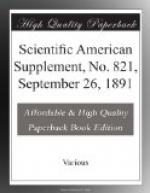* * * * *
METHOD OF PRODUCING ALCOHOL.
In carrying out my improved process in and with the apparatus employed in ordinary commercial distilleries, says Mr. Alfred Springer, of Cincinnati, O., I preferably employ separate vats or tubs for the nitric acid solution and the material to be treated, and a convenient arrangement is to locate the nitric acid tub directly under the grain tub, so that one may discharge into the other. In the upper vat is placed the farinaceous material, preferably ground, thoroughly steeped in three times its weight of water, and, where whole grain is used, preferably “cooked” in the ordinary manner. The vat into which the dilute acid is placed is an ordinary cooking tub of suitable material to resist the acid, provided with closed steam coils and also nozzles for the discharge of steam into the contained mass. Into this vat is placed for each one hundred parts of the grain to be treated one part of commercial nitric acid diluted with fifty parts of water and brought to a state of ebullition and agitation by the steam coils and the discharge through the nozzles, the latter being regulated so that the gain by condensation of steam approximately equals the loss by evaporation. The farinaceous contents of the upper vat are allowed to flow slowly into the nitric acid solution while the ebullition and agitation of the mass is continued. This condition is then maintained for six to eight hours, after which the mass is allowed to stand for one day or until the saccharification becomes complete. The conversion can be followed by the “iodine test” for intermediary dextrins and the “alcohol test” for dextrin. After the saccharification is complete I may partially or wholly neutralize the nitric acid, preferably with potassium or Ammonium carbonate, preferably employing only one-half the amount necessary to neutralize the original quantity of nitric acid used, so that the mass now ready to undergo fermentation has an acid reaction. The purpose in view here is to keep the peptones in solution also, because an acid medium is best adapted to the propagation of the yeast cells. It is not absolutely necessary to even partially neutralize the nitric acid, but it is preferable. Yeast is now added, and the remaining processes are similar to those generally employed in distilleries, excepting that just prior to distillation potassium carbonate sufficient to neutralize the remaining nitric acid is added, in order to avoid corrosion of the still and correct the acid reaction of the slop.




